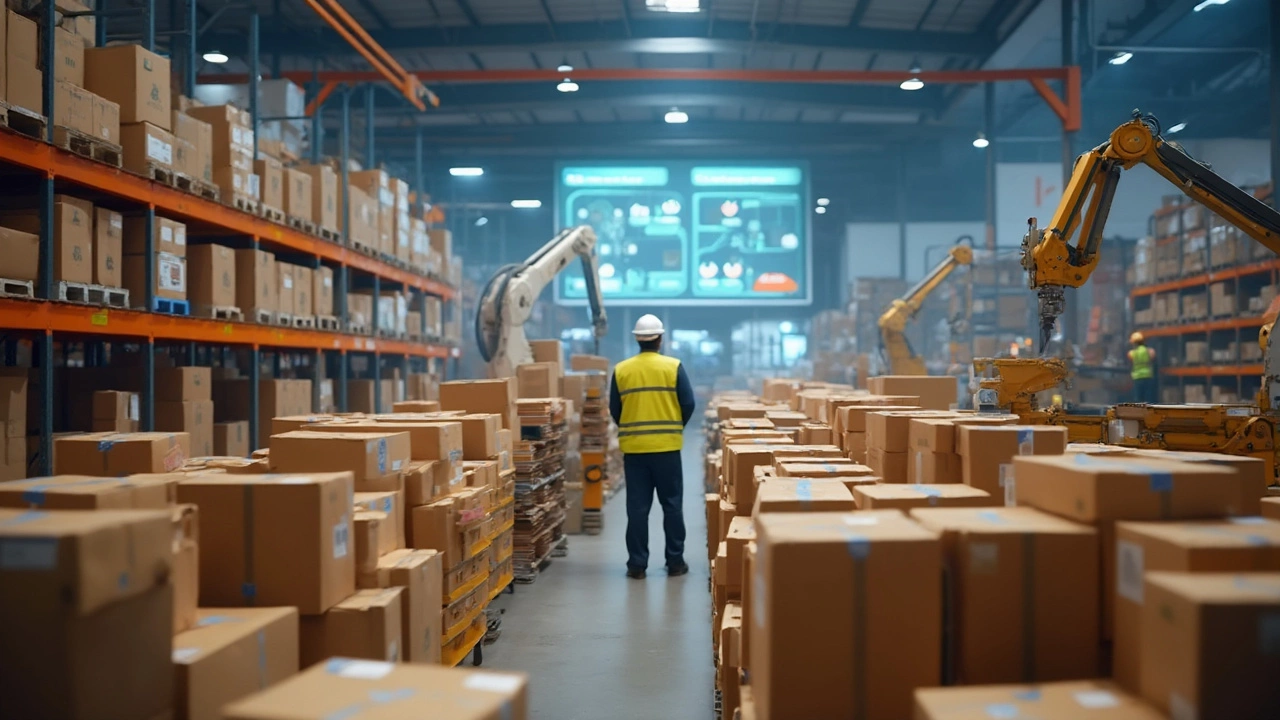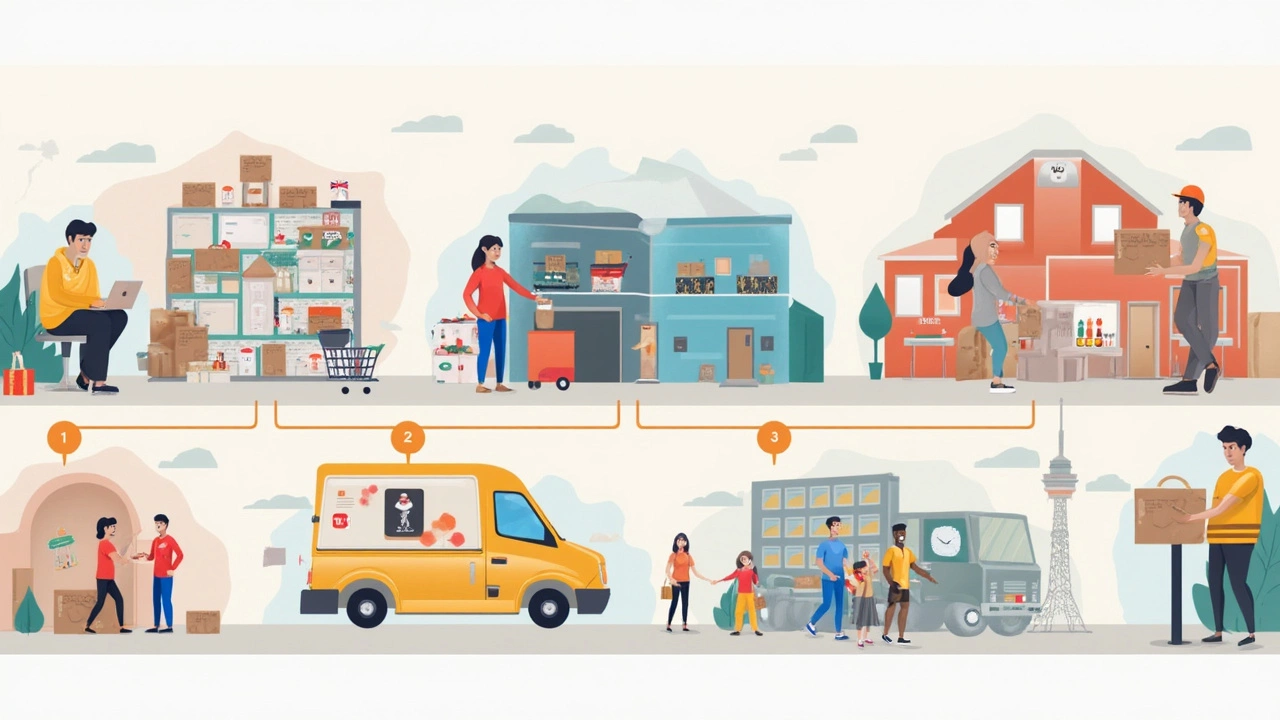Logistics in Ecommerce: What It Is and Why It Matters

Ever get that feeling of excitement tracking your package as it snakes its way toward your front door? The real magic behind that moment is logistics. In ecommerce, logistics isn’t just shipping boxes. It covers every behind-the-scenes move from the second you click 'buy' to the moment you open your delivery.
Think about it—right after an online store gets your order, a bunch of things start happening fast. The system checks if your item is in stock, someone picks and packs it, and a courier zips it off, whether that’s miles away or just around the corner. If you’ve ever returned something, you’ve used reverse logistics too. That’s all part of the same puzzle.
Quick fact: Over 70% of online shoppers say delivery speed influences whether they’ll shop at the same store again. So, logistics isn’t just back-end jargon. It’s a big reason you come back to your favorite store—or never bother with it again.
- What Does Ecommerce Logistics Actually Mean?
- How Orders Move: The Step-by-Step Breakdown
- Why Logistics Can Make or Break Your Online Shopping
- Big Challenges and Neat Solutions
- Tips for Better Ecommerce Logistics
What Does Ecommerce Logistics Actually Mean?
When people talk about ecommerce logistics, they usually mean everything that moves products from a seller to a buyer through online shopping. But it’s more detailed than just shipping. It connects every dot—inventory, packing, shipping, tracking, and even handling returns when you change your mind or something doesn’t fit.
Ecommerce logistics combines tech with good, old-fashioned moving stuff. Shops use advanced software to track thousands of products in giant warehouses. Even small businesses do this now, tracking which shelf has your favorite hoodie and how fast they can get it out the door. Once an order is placed, logistics covers:
- Inventory management (knowing what’s in stock and where it is)
- Order picking and packing (getting your actual item, not the wrong color or size)
- Shipping and delivery (choosing the best courier and timing)
- Returns and exchanges (reverse logistics—basically the process in reverse)
Here’s a stat: In 2023, U.S. ecommerce sales topped $1 trillion according to the U.S. Department of Commerce. With numbers like that, keeping the ecommerce logistics machine running smoothly isn’t just nice—it’s survival for online stores.
As one expert at Shopify put it:
"Modern ecommerce logistics is about speed and accuracy, but it’s also about giving shoppers more control and visibility than ever before."
If a store messes up any of these steps, word spreads fast—especially with quick reviews and social media. The shops that make everything seamless? They’re usually using clever logistics tech behind the scenes.
How Orders Move: The Step-by-Step Breakdown
When you hit that 'place order' button, it kicks off a fast track that’s honestly wild when you look close. Here’s how ecommerce logistics really works from start to finish—way more happens behind the scenes than most people guess.
- Order Received: The online store's system grabs your order instantly. Good ecommerce stores automate this, so there’s no waiting around.
- Inventory Check: Next up, the system checks if the item is actually in the warehouse. Advanced stores use real-time inventory tracking. If it’s not in stock, you’ll usually get a 'backorder' notice right away.
- Picking: This is where things go off the digital map and into the real world. Either a worker or a robot zips through the warehouse to grab your item. Some huge brands have robots handling up to 80% of picking in their warehouses—Amazon is a champ at this.
- Packing: Your item gets packed for battle—handled (hopefully) with care, some bubble wrap, and a shipping label. Many stores use branded packaging to make it feel special when you open it.
- Shipping: Your package gets picked up by a courier—could be UPS, FedEx, or even a local service for same-day delivery. You get that tracking number everyone’s obsessed with.
- Last Mile Delivery: This is the final sprint, and honestly, it’s where most delays happen. Pro tip: of all shipping problems, 53% happen during the last mile. Drivers juggle tons of packages and unpredictable stuff like traffic, dogs, and wrong addresses.
Here’s a quick look at a typical order flow, with rough timing based on industry averages:
| Step | Time (avg) |
|---|---|
| Order processing | 0-4 hours |
| Picking/Packing | 1-6 hours |
| Shipping to carrier | 4-24 hours |
| Delivery (domestic) | 1-5 days |
It doesn’t end with delivery. If you open a box and realize you ordered the wrong phone case (happened to me last month), reverse logistics jumps in. That means handling your return, refund, and restocking the item so someone else can buy it next time.
Every step relies on solid shipping and supply chain systems. Any hiccup slows down the whole chain, which is why the top online stores invest big in automation and tracking tech.

Why Logistics Can Make or Break Your Online Shopping
When it comes to ecommerce logistics, a lot rides on how smooth things run behind the scenes. Getting this wrong turns happy shoppers into lost customers fast. Mess up a delivery, miss an item, or delay an order—and people notice. In fact, a 2023 survey by Metapack found that 56% of shoppers ditched an online brand after a single poor delivery experience. That’s how cutthroat online shopping has become.
On the flip side, when shipping works well, you barely notice it. That’s the point. You just get your stuff, when you want it, where you want it. Lots of stores now offer same-day or next-day delivery in bigger cities. Even smaller shops are trying to keep up, working with local couriers or pickup services. It’s a race—and whoever sorts out their logistics first keeps the shoppers.
The real cost of messy ecommerce logistics? It piles up quickly:
- Delayed or lost shipments mean expensive refunds and wasted products.
- Poor storage and stock checks cause out-of-stock notices right after checkout (nothing annoys people faster).
- Slow return processes drive people to shop elsewhere next time.
This stuff matters for smaller brands just as much. If you run a small shop selling sneakers or baby gear, you’re playing in the same customer pool as giants like Amazon or Walmart. The big names set high expectations—others scramble to reach them. Here’s a peek at how fast things are moving:
| Delivery Option | Customer Expectation |
|---|---|
| Standard Shipping | 3-5 business days |
| Expedited Shipping | 1-2 business days |
| Same-Day Delivery | Within 24 hours |
So, solid supply chain planning and quick deliveries turn new shoppers into repeats. It’s not just about moving boxes. It’s about repeat business, brand reputation, and making sure your next online order arrives without drama. If you’re shopping online, you bet you’ll stick with stores that nail their ecommerce logistics every single time.
Big Challenges and Neat Solutions
The world of ecommerce logistics isn’t smooth sailing. Stores deal with crazy peaks, like Black Friday, when order volumes skyrocket and warehouses feel like a beehive. One missed step can delay hundreds of packages. In some countries, more than 25% of online orders get delayed during these high-traffic times. If you’ve ever waited longer for a package than the site promised, that’s probably why.
Besides volume spikes, keeping real-time inventory updates is a real pain. If a store shows something as in stock but it’s gone, shoppers lose trust fast. Small errors here lead to canceled orders and angry emails. And let’s not forget the cost—shipping fees eat away at profits, especially with customers expecting cheap or even free shipping.
Returns? Those are brutal too. Around 20% of stuff bought online, especially clothes or shoes, gets sent back. Handling returns, checking if products can go back on sale, or repackaging them eats up time and resources.
But there are ways stores are fighting back. Automated fulfillment centers keep track of every item, pack orders faster, and cut human error. Some sellers use Smart Routing, sending packages from the closest possible warehouse to get stuff out quicker and cheaper. Big online stores use AI to guess what products will be hot, so they prepare stock where it’s needed most.
- Cloud-based ecommerce logistics software helps stores update inventory and order status in real time, syncing info between the online shop and the warehouse.
- Major carriers, like USPS and FedEx, now offer tracking APIs that online shops can plug into their websites, so customers always know where their order is.
- Some businesses test out crowdsourced local delivery, like using locals to drop off packages, slashing delivery times and costs, especially in big cities.
If you’re curious how these tweaks stack up, here’s a quick comparison of shipping methods and average last-mile delivery times for U.S. online stores, based on data from 2024:
| Shipping Method | Average Delivery Time (days) |
|---|---|
| Standard Carrier | 5 |
| Local Couriers | 2-3 |
| Same-Day (Crowdsourced) | 0-1 |
Staying ahead in ecommerce logistics isn’t about fancy tricks. It’s making sure everything, from buying to returns, runs as smoothly and cheaply as possible—even when things get wild.

Tips for Better Ecommerce Logistics
Smooth ecommerce logistics isn’t just for giant brands like Amazon. If you run a small online store or dream of starting one, there are plenty of ways to level up how you get products to your customers fast and without a headache.
- Choose the right warehouse location: Shipping from a warehouse close to your main group of buyers shaves days (and shipping costs) off deliveries. Some businesses use multiple warehouses around the country to hit this goal.
- Go digital with inventory management: Relying on spreadsheets is risky. Inventory software tracks your stock in real-time, helps prevent overselling, and can even automate reordering. Data from Logistics Management magazine shows companies using inventory management software reduce stock errors by up to 30%.
- Offer delivery options: Not everyone needs overnight shipping, but some shoppers do. Give choices—standard, express, local pickup—so people don’t feel stuck. This flexibility bumps up customer satisfaction and can keep basket abandonment rates lower.
- Stay transparent with tracking: Customers want to know where their stuff is. Send tracking numbers right away, keep them updated if there are delays, and make it easy to contact support if anything goes wrong. Real-time tracking reduces "where is my order" calls by almost half.
- Handle returns like a pro: Returns are a big part of online shopping, like it or not. Make it simple by including prepaid labels or clear return instructions. A smooth return process can actually win loyalty—41% of shoppers say easy returns make them likely to shop again.
Here’s a quick comparison of key logistics strategies and their impact:
| Strategy | Main Benefit |
|---|---|
| Multiple Warehouses | Faster, cheaper shipping |
| Inventory Software | Reduces errors, streamlines reordering |
| Flexible Delivery | Higher customer satisfaction |
| Transparent Tracking | Fewer support tickets |
| Easy Returns | Higher repeat business |
One more tip before you go: Don’t be afraid to test new solutions. Technology in ecommerce logistics is changing fast—sometimes a simple upgrade, like barcode scanning or automated shipping label printers, saves you hours each week and keeps those stress levels down, too.